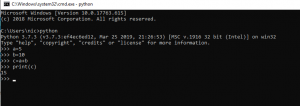Artificial Intelligence
Artificial intelligence is a branch of computer science which deals with such machines or computers that can do the jobs as well as humans like in order to have ability to think, consider the actions to be taken and take decisions like humans.
Various Definitions of Artificial Intelligence:-
Herbert Alexander Simon: Artificial Intelligence (AI) is research area, application, and instructions are form rather than numbers and information process based on heuristic methods or by a number of rules related to computer programming to do the things that viewed as intelligent
Rich and Knight [1991]:– Artificial Intelligence (AI) is a study of how to make computer do things as good as humans.
Encyclopedia Britannica:– Artificial Intelligence (AI) is a branch of computer science that represents knowledge in symbols.
Propositional Logic
Propositional logic is logic at the sentential level. Sentences considered in propositional logic are not arbitrary sentences but are the ones that are either true or false, but not both. These kind of sentences are called propositions.
i.e. a proposition is a statement that is either TRUE or FALSE.
It analyzes a way of composing a complex sentence (proposition) from elementary propositions by means of logical connectives.
Valid sentences or sentences in Propositional Logic are determined according to the rules of propositional syntax. This syntax governs the combination of basic building blocks such as propositions and logical connectives. Propositions are elementary atomic sentences. Proposition may be either true or false but take no other value.
E.G: It is raining.
Snow is white.
We use capital letters, sometimes followed by digits, to stand for propositions; T and F are special symbols having the values true or false, respectively. The following symbols are used for logical connectives.
~ for not or negation
& for and or conjunction
V for or disjunction
-> for if….then or implication
<-> for if and only if or double implication
Syntax:
If P and Q are formulas the syntax of PL is given as follows.
(~P)
(P & Q)
(P V Q)
(P -> Q)
(P <-> Q)
Semantics:
The semantics or meaning of a sentence is just the true or false value; i.e. it is an assignment of a truth-value to the sentence. An interpretation for a sentence or group of sentences is an assignment of a truth-value to each propositional symbol.
t & t’ denote any true statements, f& f’ denote any false statements and a denotes any statement(either true or false).
Properties Of Statements:
Satisfiable: A sentence is satisfiable if there is some interpretation for which it is true.
Contradiction: A sentence is contradictory if there is no interpretation for which it is true.
Valid: A sentence is said to be valid if it is true for every interpretation. Valid sentences are also known as tautologies.
Equivalence: Two sentences are equivalent if they have the same truth-value under every interpretation.
Logical Consequence: A sentence is a logical consequence of another if it is satisfied by all interpretations which satisfy it first.









